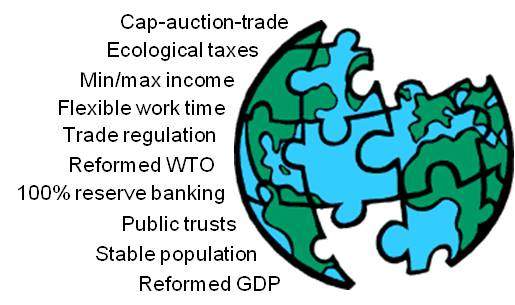The Guardian and Monbiot versus Forbes and Worstall
 by Herman Daly
by Herman Daly
In his Guardian column, criticizing growth as “The Insatiable God,” George Monbiot writes:
Is it not also time for a government commission on post-growth economics? Drawing on the work of thinkers like Herman Daly, Tim Jackson, Peter Victor, Kate Raworth, Rob Dietz and Dan O’Neill, it would investigate the possibility of moving towards a steady state economy: one that seeks distribution rather than blind expansion; that does not demand infinite growth on a finite planet…
It is no surprise that we at CASSE strongly agree with Monbiot. Nor does it come as a surprise that a columnist for Forbes, Tim Worstall, would disagree. What is surprising is that Worstall uses me in support of his position (with which I disagree) and against Monbiot (with whom I agree). How does he manage such a reversal? By conflating growth (quantitative physical increase) with development (qualitative improvement), and claiming that 80% of GDP increase is due to qualitative “growth” (total factor productivity), and is therefore independent of increase in physical resource use–when in reality the “total” factor productivity increase in question is mainly caused by an increase in physical resource throughput. This requires further explanation.
In a previous article, also criticizing Monbiot, Worstall states his position more completely, as quoted below, [my brackets inserted].
Value add [added] is economic growth, not more stuff. And we can take this insight to an extreme as well, that extreme being the steady state economy proposed by Herman Daly. In this world resources are only abstracted from the environment if this can be done sustainably. And we recycle everything of course [not energy or highly dispersed materials]. So, in such a world can we still have economic growth? We have no more access to more stuff to make stuff out of: so is growth still possible? Yes, of course it is. For we can still discover new methods of adding value to those resources that we do have available to us through our recycling. Daly calls this qualitative growth rather than the quantitative growth that we cannot have. [Actually I speak of “qualitative improvement” to emphasize that technology is not a cardinally measurable quantity that can properly be said to grow]. But there’s absolutely no difference at all between this and the more conventional economic descriptions of growth. Qualitative growth is akin to growth through an increase in total factor productivity as opposed to growth via the use of more inputs [only remember that “more inputs” should include natural resources, but does not]. And Bob Solow once pointed out that 80% of the growth in the market economies in the 20th century came from tfp (total factor productivity) growth, not the consumption of more resources. We’re just using different words to describe exactly the same thing here [not really].
Now if this were true we could keep resource throughput constant, avoiding most of the increasing environmental costs of growth, and still have 80% of historical GDP growth. Once matter-energy throughput is stabilized at an ecologically sustainable level we could presumably have significant GDP growth forever with minimal environmental costs, thanks to increasing total factor productivity. I would be happy if that were true, but I am pretty sure that it is not. Nevertheless, if Forbes believes it, maybe they would then endorse a policy of limiting resource throughput (cap-auction-trade or carbon tax), and be content with still significant GDP growth based only on total factor productivity increase? Don’t hold your breath. Worstall explicitly discounts any notion of resource scarcity, so why limit throughput? But, just for good measure, he argues here that even with resource scarcity, technology can, by itself, provide most of our accustomed growth, as it supposedly has in the past.
Worstall’s source for the 80% figure is the “Solow Residual,” which is commonly misinterpreted as a measure of total factor productivity. As calculated, it is a measure of “two-factor” productivity, the two factors being labor and capital. The Cobb-Douglas production function that underlies this calculation omits natural resources, the classical third factor. This means that it cannot possibly be an accurate analytical representation of production. It is like a recipe that includes the cook and the oven, but omits the list of ingredients.

As natural resources becomes increasingly scarce, can we afford to ignore their contributions to increases in production? Photo Credit: Claire.Ly
Value added has to be added to something, namely natural resources, by something, namely labor and capital. The cook and the oven add value to the ingredients, but nothing happens without the ingredients. Our empty-world economic accounting attributes all value to labor and capital, and treats natural resources in situ as superabundant free gifts of nature. But in today’s full world, resources are not only scarce but have become the limiting factor. Leaving the limiting factor out of the analysis makes the Cobb-Douglas production function not only incomplete, but also actively misleading.
Nevertheless, Worstall’s 80% figure comes from respected economists who have used the Cobb-Douglas production function in a statistical correlation–an exercise to see how much of increased production can be statistically explained by increases in labor and capital. The residual, what is not explained by labor and capital increase, is attributable to all causes other than labor and capital, including, for example, technology improvement and increased material and energy throughput (natural resource use).
A large residual indicates weak explanatory power of the theory being tested–in this case the Cobb-Douglas theory that production increase is due only to capital and labor increase. But instead of being embarrassed by a large unexplained residual, some economists were eager to “explain” it as an indirect measure of technological progress, as a measure of improvement in total factor productivity. But is technology the only causative factor reflected in the residual? No, there are surely others, most especially the omitted yet rapidly increasing flow of natural resources, of energy and concentrated minerals. The contribution of energy and materials from nature to production is also part of the residual, likely dwarfing technological improvement. Yet the entire residual is attributed to technology, to total factor productivity, or more accurately “two-factor” productivity, in the absence of natural resources, the classical third factor.
As the natural resource flow greatly increases, and capital and labor transform that growing resource flow into more products, then of course the measured productivity of capital and labor increases. This increased “total” factor productivity, due mostly to increase in the ignored factor of natural resources, is then appealed to as evidence of the unimportance of natural resources, given the “empirical finding” that total factor productivity improvement (technology) “explains” so much of the observed increase in production. This reasoning is clearly specious. It is the increased resource use that explains the increase in total factor productivity (i.e. two-factor productivity), which cannot then be used as a reason to discount the importance of its own cause, namely an increased flow of natural resources. Indeed, the unimportance of natural resources could not possibly be an empirical finding of any statistical analysis based on the Cobb-Douglas production function, because that function assumes the unimportance of natural resources from the beginning by omitting them as a factor of production. This is a big confusion and Worstall is not the only one misled by it.
In conclusion, I think the Guardian and Monbiot’s position is not in the least weakened by the criticism from Forbes and Worstall, but that reliance on the Cobb-Douglas production function should certainly be weakened.
 Herman Daly is an emeritus professor at the University of Maryland School of Public Affairs and a member of the CASSE executive board. He is co-founder and associate editor of the journal Ecological Economics, and he was a senior economist with the World Bank from 1988 to 1994. His interests in economic development, population, resources, and environment have resulted in more than 100 articles in professional journals and anthologies, as well as numerous books.
Herman Daly is an emeritus professor at the University of Maryland School of Public Affairs and a member of the CASSE executive board. He is co-founder and associate editor of the journal Ecological Economics, and he was a senior economist with the World Bank from 1988 to 1994. His interests in economic development, population, resources, and environment have resulted in more than 100 articles in professional journals and anthologies, as well as numerous books.








How have you put up with this ignorance for so many years? I had no idea the Cobb-Douglas production function was still being misused. I vividly remember my Advanced Macro class when the prof. (you know who) used the C-D function to “investigate” whether or not the economy could continue to grow while using fewer and fewer natural resources – amazingly it could! Oh my!
I would like to nominate you for the “Job (Old Testament) Patience Award.” And your “friends” like Worstall should receive the “Job’s Friends Ignorance Award.”
George Monbiot destroyed his years of credibility in one fell swoop when he came out for nuclear power. Since then I don’t even bother reading him.
There are lots of activists and regular folks just like me who don’t read anything by Monbiot anymore. I suggest you stop using him as a reference. Otherwise you will lose readers too.
I think it worthwhile to point out that, in 1974, “Bob Solow” famously said:
“If it is very easy to substitute other factors for natural resources, then… the world can, in effect, get along without natural resources, so exhaustion is just an event, not a catastrophe.”
But times change, and so do reasonable minds, as Solow demonstrated in 2008, when he—not so famously—pointed out:
“It is possible that … continued growth will be too destructive to the environment and too dependent on scarce natural resources … There is nothing intrinsic in the system that says it cannot exist happily in a stationary state.”
Although I, like Mr. Haugen, do not agree with those (Monbiot is NOT alone) who advocate for nuclear, I ask that we forgive them this discretion. This willingness to write-off divergent views is the undoing of the progressive movement. Mr. Monbiot has contributed much to this movement, and I would rather keep him close. Fact is that nuclear is losing support and in time will be rejected. The most important conversation about the future of energy is to move away from fossil fuels, and the pro nuclear folks should be welcomed to that chorus.
Thank you to Monbiot, Daly, and CASSE, for exposing the dangers of believing in infinite growth!
Ken Melamed makes a serious error when he accepts half measures. Down this road lies geo-engineering and other false narratives. Monbiot didn’t just accept nuclear power as a default scenario, he forcefully argued for it.
First, even to someone like myself who isn’t at all technically conversant (Cobbs-Douglas and whatnot) in economics either mainstream or otherwise, Wordall loses me and convinces me he’s muddled when he thinks [absent Daly’s bracketed comment] that everything can be recycled. A remedial course in Ecology 101 would be useful. Second, I appreciate the clarity of Daly’s statement that technology “is not a cardinally measurable quantity.” This puts, with precision, the problem I’ve had in the past with references to the I=PAT formula. Third, yes (and I’m pretty confident Daly has said this elsewhere), if their belief is really what they say it is, then a policy instrument of placing limits on resource throughput would test their belief empirically, and if there is then a balking at agreeing to the policy instrument, it’s evidence of unwillingness to put their real-world-substantiation risk where their abstraction-philosophy is.
I completely agree with Walter Haugen above: it’s really odd that you mention George Monbiot and not explain anything about his idiotic support for nuclear power. It does make your credibility go down. A lot.
I agree, don’t let Monbiot’s views about nuclear power distract you from his other points of view which for all intents and purposes are deep green and should be welcomed if ecological restoration and socio-economic stabilization mean anything to anybody.
We don’t normally agree on everything even with our best friends!
What always puzzles me about economic growth is that I think there can be sustainable economic growth if it is focused on creating rather than depleting natural resources which are good for the planet and good for people, i.e natural resources that contribute towards providing for survival needs, biodiversity enhancement and ecological restoration, such as re-forestation and small-scale farming initiatives and not palm oil, soy bean or biofuel plantations. However I guess natural (or ecological) economic growth as opposed to synthetic (or chemical) economic growth does not distribute wealth and power to the corporate elites so is not usually advocated, promoted or subsidized.
For the record I oppose nuclear power, but I agree with Monbiot on many other issues. If this creates a problem for some readers, well, I think it is their problem, not mine.
Thanks to Neil Dawe for pointing out the difference between Solow 1974 and Solow 2008, and for noting that reasonable minds change. Solow’s earlier statement was famous because it was in a Presidential Address to the American Economic Association. The later statement was not so famous because it was a quotation from an interview with Solow in an article in Harpers Magazine by someone else. Nevertheless it is evidence that reasonable minds do change.
Pardon me for intruding as I am new to the discussion. I have read (and heard on NPR) in the past that 25% of the world’s population does not have reliable access to water (clean or potable I presume) and 1/3 of that population does not have reliable access to electricity. In the US alone, there is varying estimates of poverty, millions of children who go to bed hungry and have food insecurity. My question is this: Is it the diagnosis of these condition that the problem is exclusively one of distribution? Capital as a function of poverty may be argued to be a matter of distribution, perhaps, but energy seems a difficult case to make. Food also; no matter how rich you are, there is a hard limit to how much you food you can consume. Water can be wasted much easier than food. The point is this. If poverty is a problem ( and I think it is) and we accept a steady state economy, (which I take to mean ending the growth of production-based enterprises), then the assumption must be that production of necessary materials must be sufficient today to alleviate the poverty inherent in these simple statistics. My problem with a “steady state economy” then, is that it would limit growth just when the poor of the world are within reach of having enough. If the problem of poverty is purely a matter of distribution, then the basis of this distinction should be to demonstrate there is enough to go around? Then a steady state production system could be made ecological sound. But if there is indeed a shortage of water and electricity, isn’t limiting growth consigning the poor to eternal poverty?
In addition, isn’t growth a narrow economic distinction that fails to encompass the present problems future growth much solve? Isn’t the cure for cancer growth? That is, doesn’t it require more resources not less? Further, isn’t the economic model of present medical research inverted, that is medical problems only gain research successes if and when there are enough people affected by them to justify the costs. Therefore, the smaller the medical problem (disease, or damage) the less research funding would be available in direct proportion. How does steady state economics solve this problem? Or should it? Ebola only became a US research priority when the terror of it gaining huge numbers and spreading became publicized.
A third thought, isn’t population stabilization possible only in the “rich” countries? The Malthusian dilemma has given way to the middle and upper class phenomena of fewer children as children move from the agrarian cost-benefit to the urban cost-liability in society. This seems to imply that reducing growth pressure from increased human population would accrue most naturally from raising the human population out of poverty–to the extent that survival essentials become certain both now and in the future, doesn’t that allow short term thinking descried herein to give way to a longer term view of the world? Where is the certainty that the end of poverty requires a solution to what is merely a distribution problem and not a matter of actual physical production? For if it is actual production, then the steady state economy would mean persistent poverty and the virtual end of hope of ever escaping.
If this is not so, if distribution is the problem, then isn’t the first demand of a steady state economy to demonstrate that it can protect production and genuinely retain a level of production sufficient to keep poverty at bay? Where is the protection of the human productivity that gives us the problem of distribution? I lived and worked in agriculture in China for 3 years and my observation is that their 1.4 billion people are 8-10 days away from hunger at all times. They have an essentially “fresh food” diet that has a spoilage expectation of a few days because of a lack of infrastructure to retain it for longer. In 2008 the Chinese government implemented a program to put a fridge in every home and when I arrived in 2009, unplugged fridges were everywhere in the countryside. Brown outs where common in the Guangxi area where I was working. I took the “unplugged” condition to reflect two things, 1) insufficient capital to pay the additional electric bills or 2) insufficient electricity to power millions and millions of fridges through the countryside.
This was not a matter of distribution, The Economist noted last week that China is set to create renewable energy (renewable! aka green) in the same amount of giga watts that equals the whole of the US energy consumption today. That surely is growth and not subject to redistribution.
So, my point is this, isn’t a steady state economy going to be keeping the poorest of the world in poverty because of the profound lack due to insufficient production? Until there is production sufficient to everyone, isn’t this the result of a steady state economy? Granted that conventional economic theory has no provision for steady state economics, so we need to understand how that would work but isn’t more production of electricity, water, food, shelter and clothing still more crucial? More to the point, isn’t steady state economics without this condition ultimately going to create the very class society progressive thinking descries with a bedrock of poor at the bottom caused simply by the lack of production? Or is the argument herein that production is sufficient?
Dear Jeff,
As you say, you are new to the discussion, But then so are a lot of other people who are probably asking themselves the same questions you raised. It is always worthwhile to review a discussion from the beginning.
I agree that all our problems would be easier to solve if we were richer—if we had more water, more energy, more research, a bigger Earth, etc. That is a truism. The question at issue is whether or not further aggregate growth (in resource throughput and its close correlate GDP) is still making us richer as it did in the empty world, or if in the full world of today growth costs more than it is worth at the margin and now makes us poorer. For a discussion of such “uneconomic growth” (see “Three Limits to Growth”, and “Krugman’s Growthism”, this web site).
Curing poverty is certainly the priority, and redistributing wealth from rich to poor is one policy. Another is to focus on qualitative development (improved technology, more efficient allocation, and better ethical priorities) instead of aggregate quantitative growth. Another policy is to seek a steady-state population. You might browse through previous essays on this web site to find discussions of the other questions you raised.
Best wishes,
Herman